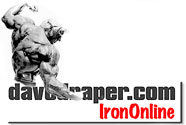Bodybuilding Legend: Dave Draper
Before Arnold, Dave Draper (better known as the Blond Bomber) personified the bodybuilding lifestyle for millions of fans. Then he disappeared
Story
by: By Jeff O'Connell, Muscle & Fitness
The photographs, intended for the disposable medium of the magazine page, became iconography, referencing Southern California from the middle '60s through the early '70s just as surely as the music of the Beach Boys did. Listen to the trippy swirl of "Good Vibrations" and picture Dave Draper horsing around with Arnold Schwarzenegger, Franco Columbu and Frank Zane, the four of them casually inventing new training styles in Joe Gold's original gym, the setting for what would become bodybuilding's big bang. Hear "Surfer Girl" and see Draper bending some weird contraption like a twig, grinning ear to ear, a gorgeous blonde on either shoulder.
The names Schwarzenegger and Columbu suggested origins in far-off, distant lands, but Dave Draper must have sprouted fully formed from the sands of Santa Monica, so at home did he look amidst the beach bunnies and barbells. His name sounded like it came straight from Hollywood, anyway -- with a nickname, The Blond Bomber, to match -- so when Johnny Carson needed someone with whom to do push-ups on the air, or movie producers sought to cast an Adonis-like boyfriend for the impossibly beautiful Sharon Tate in the surf romp Don't Make Waves, choosing the archetypal West Coast bodybuilder was easy.
Mythologizing Size
Only he wasn't from California. Appearances can be deceiving, and just as the composer of that surf music, Brian Wilson, was beached in his own bedroom, flirting with insanity, Draper, who in magazine spreads mythologized the supreme self-confidence that comes with muscle, was in reality an intensely shy young man from New Jersey. Setting a precedent that Arnold would eventually follow, Draper had come westward at the invitation of Joe Weider, whose instincts told him that the strapping stud belonged in front of a camera lens selling weight sets and protein powder, not in a Union City, New Jersey, warehouse preparing them for shipment, which he had been doing as a teenager in Joe's employ.
Once in Southern California, Draper rose meteorically in the sport as measured by contest results, racking up a string of titles that certified his All-American-ness: Mr. America in 1965, Mr. Universe in 1966, Mr. World in 1970. Arnold would launch from his victories into movie superstardom and more, but The Blond Bomber quit, for good, at age 28. Meteors flame out by definition, but few disappear as abruptly as he did.
He didn't lose his mind like Wilson did for a time, yet he left public view, carving out a second career as a woodworker, although much of that era was spent drifting through a haze of alcohol and drugs. "I got off the main avenue and onto the side streets and stayed there for a long time," is how The Blond Bomber puts it in hindsight. Remarkably, even during his darkest days, he still trained diligently for a minimum of 75 minutes 4-5 times a week.
Someone goes to the gym in such disrepair only if his life depends on it, and strange as it might sound, that impulse sheds light on the paradox of Draper's life in bodybuilding. He may have been ill at ease in the limelight, but he felt most at home in the inner sanctum of the iron dungeon. Where bodybuilding was concerned, training was everything to a purist like him, which meant that the trappings (the magazine covers, the fame, the contests, the money) would come to mean little, or at least not enough to keep him in the game. What mattered was the process, the improvisation, arranging sets and reps in endlessly inventive ways, shocking his system to its core. The cliché refers to bodybuilders as sculptors, but Draper's approach was more primitive, akin to Jackson Pollock wildly flinging paint around in his barn-studio.
Return of the Prodigal Son
When Draper finally resurfaced, it was in Santa Cruz, California, where he started one World Gym franchise, and then a second. He has also written two bodybuilding books, published a handful of like-minded works by others, and branched out on a small scale into supplements (Bomber Blend protein powder) and exercise equipment (the Top Squat), all sold through IronOnline, the website that disseminates Draper's prolific, freewheeling musings on the bodybuilding life.
In a profile of Draper published in the November 2000 issue of GQ magazine that completed the resurrection, author Robert Draper (no relation) called his namesake, now 62, the "anti-Arnold," contrasting their temperaments and career trajectories, not implying enmity between the two men. (On the contrary, Dave Draper, on his website, wrote this of encountering Arnold at the 2004 Fitness Weekend in Columbus: "Where does this guy get his energy, determination, motivation and courage? Arnold gets up every morning, splashes water on his face, walks over to the cliff and jumps.") That the two would still meet under such circumstances shows that even though they branched off in different directions, the roots from which they both grew are still fully intact, well tended and intertwined. Arnold is bodybuilding's global ambassador now, but Draper has become its prose-poet laureate, wielding the pen as mightily as he once did the barbell.
"My most vivid workouts are set against the backdrop of the Muscle Beach Gym in the early 1960s," Draper has written of the early years when bodybuilding as we know it was still like a frog sitting on its hind legs, full of potential but yet to leap. "...This famous, beloved relic once located on the unspoiled shores of Santa Monica was relocated by the encouragement of the city council to the underground basement of a collapsing retirement hotel four blocks inland.
A very long, steep and unsure staircase took you to a cavernous hole in the ground with crumbling plaster walls and a ceiling that bulged and leaked diluted beer from the old-timer's tavern above. Puddles of the stuff added charm to the dim atmosphere where three strategically placed 40-watt light bulbs gave art deco shadows to the rusting barbells, dumbbells and splintery, handcrafted two-by-four benches and sagging milk crates. You have no idea how proud I am to have this theater... and the real-life plays that unfolded day after day as part of my experience. It's pure gold. The magic didn't come from the pharmacist; it came from the soul, the era, the history in the making, the presence of uncompromised originality yet to be imitated."
Read more from this classic time period in this excerpt from West Coast Bodybuilding Scene
>Story by: By Jeff O'Connell, Muscle & Fitness
Click here to see more from the Draper history file

